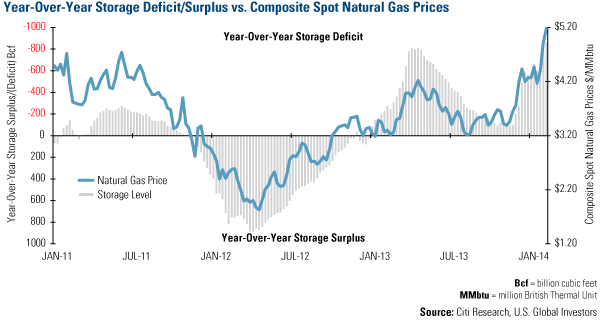Energy and Natural Resources Market Radar (March 3, 2014)
Strengths
- West Texas Intermediate crude oil gained 5 percent in February and closed above $100 a barrel for a twelfth-straight day on strong weather-related demand and a weaker U.S. dollar.
- The price of nickel posted its biggest monthly gain in more than a year as a result of speculation that supplies will tighten as Indonesia, the world’s top exporter, maintains a ban on unrefined ore shipments.
- Vale opened its Totten Mine in Ontario’s Sudbury Basin, its first base metal mine in the area in more than 40 years. The construction of the mine, which will produce copper, nickel and precious metals over the next 20 years, took more than seven years with a budget of more than $700 million.
Weaknesses
- Natural gas futures headed for the biggest weekly drop in 17 years in New York, as the March contract expired and a government report showed U.S. stockpiles of the heating fuel declined less than estimated this week.
- The Steel Index (TSI) 62 percent spot iron ore prices have dropped back to $119.10 per tonne ($119.10/t) mid-week, the lowest level since July 2013.
- Thermal coal spot prices are currently at their lowest level since last September, with the DES ARA Index and Newcastle benchmark at $76.25/t and $77.30/t as of last Friday. We believe that the main cause of the fall in price has been demand weakness in both the Atlantic and Pacific basins.
Opportunities
- Solar developers around the world will install record capacity this year as a thriving Chinese market drives growth, a Bloomberg survey showed, as manufacturers in the $102 billion industry began to return to profit. About 44.5 gigawatts will be added globally, a 20.9 percent increase on last year’s new installations, according to the average estimate of nine analysts and companies. That is equal to the output of about 10 atomic reactors.
- Cameco Corp., Canada’s largest uranium producer, welcomed a commitment by Japan to nuclear power almost three years after the meltdown of three reactors at the Fukushima Dai-Ichi nuclear power plant. Prime Minister Shinzo Abe is seeking the restart of the nation’s 48 reactors, all of which are idled for safety checks.
- Hebei, the largest steel-producing province in China, is targeting 60 million tonnes of capacity closures by 2017. If implemented, this would have a huge impact on steel capacity utilization rates and steel margins. Recently, the government demolished 15 blast furnaces as part of the drive to reduce capacity and improve environmental performance. The level of detail in the targets for closure suggests there is an imperative to achieve the closure targets this time.
Threat
- China’s steel industry will not see a quick end to its troubles, as overcapacity has reached staggering proportions and structural adjustments to the economy have complicated the sector's situation, according to CISA. China has 300 million tonnes of surplus steel output capacity, which is twice the output of the European Union in 2013.
- The Democratic Republic of Congo and mining firms fail to agree on the new mining code. As a result, the government extended talks by a week to overcome differences on proposed tax changes in the mining code.
















